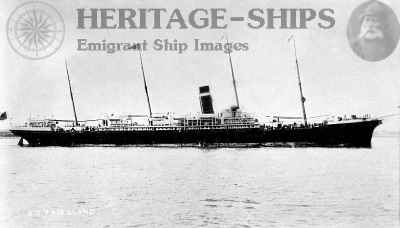
Friesland, American Line steamship
Support Norway Heritage: Purchase a copy
The Friesland was built on the Clyde, in the yard of J. & G. Thomson, who also built the
City of Paris and the
City of New York. The Friesland was built as a four mast vessel. The first three masts were square rigged, while the fourth, or jigger mast, was a fore-and-after. The Friesland was considered to be one of the safest vessels afloat at the time of her launching. Along the upper decks a number of large lifeboats hang in patent davits, from which they could be lowered at a moment's notice. She had a double bottom throughout and was capable of carrying water ballast to the amount of 1,000 tons. This enabled her at any time to render her draught at both ends equal. She was constructed of mild steel and her watertight bulkheads were of the best material available at the time of building. Her engines were of the
triple expansion type and she was supplied with all of the latest improvements in steam appliances. She was lighted throughout by electricity. Her cabin could accommodate 200 persons. The staterooms contained every facility for comfort, and the saloon was a magnificent apartment, it resembled a large hall, and it was covered by a steel deckhouse. Windows in the sides gave the passengers a good view of the deck. The second cabin of the Friesland was a handsome apartment and was also covered by a steel deckhouse. In the between decks there were comfortable quarters for 800 immigrants. The
steerage rooms were well lighted and well ventilated.